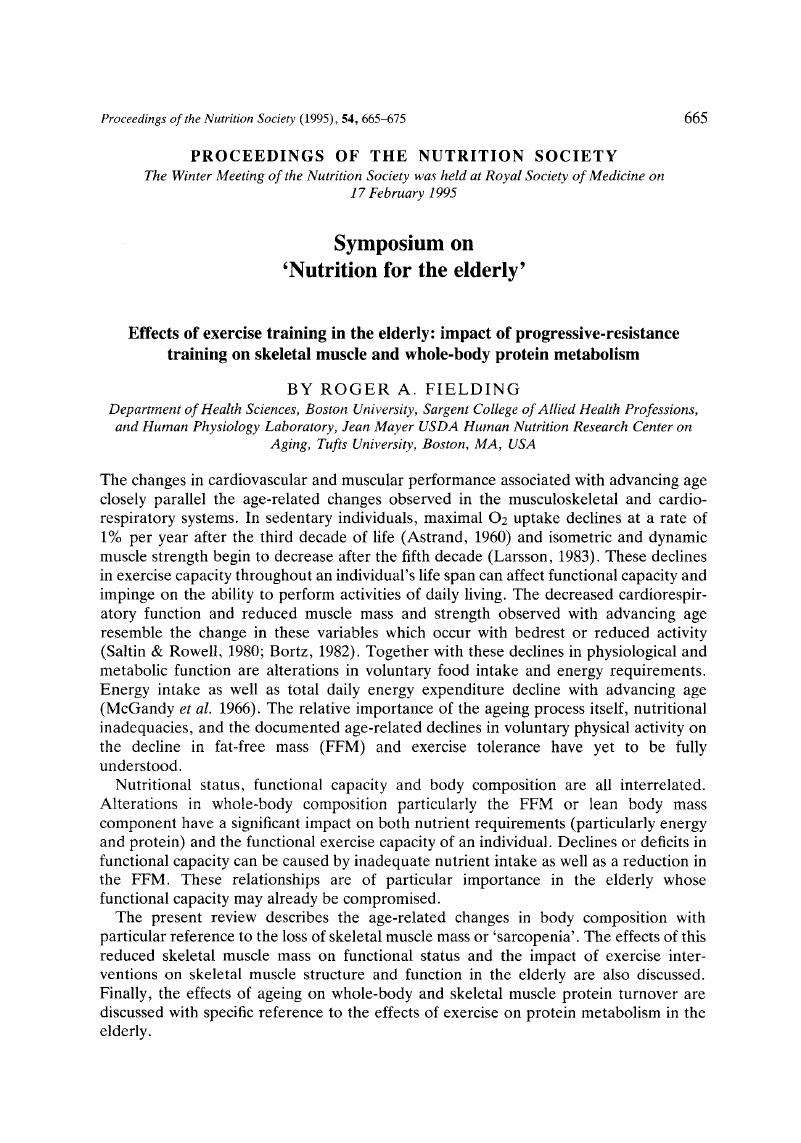Crossref Citations
This article has been cited by the following publications. This list is generated based on data provided by Crossref.
Fiatarone, Maria A.
1995.
Fitness and Function at the End of Life.
Journal of the American Geriatrics Society,
Vol. 43,
Issue. 12,
p.
1439.
B. Heymsfield, Steven
Wang, ZiMian
Baumgartner, Richard N.
and
Ross, Robert
1997.
Human Body Composition: Advances in Models and Methods.
Annual Review of Nutrition,
Vol. 17,
Issue. 1,
p.
527.
Millward, DJ
Fereday, A
Gibson, N
and
Pacy, PJ
1997.
Aging, protein requirements, and protein turnover.
The American Journal of Clinical Nutrition,
Vol. 66,
Issue. 4,
p.
774.
de Jong, Nynke
Paw, Marijke J.M. Chin A
de Groot, Lisette C.P.G.M.
de Graaf, Cees
Kok, Frans J.
and
van Staveren, Wija A.
1999.
Functional Biochemical and Nutrient Indices in Frail Elderly People Are Partly Affected by Dietary Supplements but Not by Exercise.
The Journal of Nutrition,
Vol. 129,
Issue. 11,
p.
2028.
Spungen, Ann M.
Wang, Jack
Pierson, Richard N.
and
Bauman, William A.
2000.
Soft tissue body composition differences in monozygotic twins discordant for spinal cord injury.
Journal of Applied Physiology,
Vol. 88,
Issue. 4,
p.
1310.
Feland, J.Brent
Myrer, J.W.
and
Merrill, R.M.
2001.
Acute changes in hamstring flexibility: PNF versus static stretch in senior athletes.
Physical Therapy in Sport,
Vol. 2,
Issue. 4,
p.
186.
Chernoff, Ronni
2004.
Protein and Older Adults.
Journal of the American College of Nutrition,
Vol. 23,
Issue. sup6,
p.
627S.
Soeters, Peter B.
Reijven, Petronella L.M.
van Bokhorst-de van der Schueren, Marian A.E.
Schols, Jos M.G.A.
Halfens, Ruud J.G.
Meijers, Judith M.M.
and
van Gemert, Wim G.
2008.
A rational approach to nutritional assessment.
Clinical Nutrition,
Vol. 27,
Issue. 5,
p.
706.
Tsang, Tracey Wai Man
Kohn, Michael
Chow, Chin Moi
and
Singh, Maria Fiatarone
2008.
Health benefits of Kung Fu: A systematic review.
Journal of Sports Sciences,
Vol. 26,
Issue. 12,
p.
1249.
Eliot, K.A.
Knehans, A.W.
Bemben, D.A.
Witten, M.S.
Carter, J.
and
Bemben, M.G.
2008.
The effects of creatine and whey protein supplementation on body composition in men aged 48 to 72 years during resistance training.
The Journal of nutrition, health and aging,
Vol. 12,
Issue. 3,
p.
208.
Paddon-Jones, Douglas
Short, Kevin R
Campbell, Wayne W
Volpi, Elena
and
Wolfe, Robert R
2008.
Role of dietary protein in the sarcopenia of aging.
The American Journal of Clinical Nutrition,
Vol. 87,
Issue. 5,
p.
1562S.
Rivas, Donato A.
and
Fielding, Roger A.
2011.
Sarcopenia – Age-Related Muscle Wasting and Weakness.
p.
333.
Millward, D. Joe
2012.
Nutrition and sarcopenia: evidence for an interaction.
Proceedings of the Nutrition Society,
Vol. 71,
Issue. 4,
p.
566.
Paddon‐Jones, Douglas
and
van Loon, Luc
2012.
Sarcopenia.
p.
275.
Haran, Prashanth H.
Rivas, Donato A.
and
Fielding, Roger A.
2012.
Role and potential mechanisms of anabolic resistance in sarcopenia.
Journal of Cachexia, Sarcopenia and Muscle,
Vol. 3,
Issue. 3,
p.
157.
Bauer, Jürgen
Biolo, Gianni
Cederholm, Tommy
Cesari, Matteo
Cruz-Jentoft, Alfonso J.
Morley, John E.
Phillips, Stuart
Sieber, Cornel
Stehle, Peter
Teta, Daniel
Visvanathan, Renuka
Volpi, Elena
and
Boirie, Yves
2013.
Evidence-Based Recommendations for Optimal Dietary Protein Intake in Older People: A Position Paper From the PROT-AGE Study Group.
Journal of the American Medical Directors Association,
Vol. 14,
Issue. 8,
p.
542.
Paddon-Jones, Douglas
Campbell, Wayne W
Jacques, Paul F
Kritchevsky, Stephen B
Moore, Lynn L
Rodriguez, Nancy R
and
van Loon, Luc JC
2015.
Protein and healthy aging.
The American Journal of Clinical Nutrition,
Vol. 101,
Issue. 6,
p.
1339S.
Wallis, Lisa J.
Szabó, Dóra
Erdélyi-Belle, Boglárka
and
Kubinyi, Enikö
2018.
Demographic Change Across the Lifespan of Pet Dogs and Their Impact on Health Status.
Frontiers in Veterinary Science,
Vol. 5,
Issue. ,
Apostolopoulos, Nikos C.
2018.
Stretch Intensity and the Inflammatory Response: A Paradigm Shift.
p.
189.
Arentson-Lantz, Emily
Galvan, Elfego
Wacher, Adam
Fry, Christopher S.
and
Paddon-Jones, Douglas
2019.
2,000 Steps/Day Does Not Fully Protect Skeletal Muscle Health in Older Adults During Bed Rest.
Journal of Aging and Physical Activity,
Vol. 27,
Issue. 2,
p.
191.



